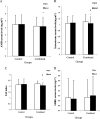Modulation of hormonal, metabolic, inflammatory and oxidative stress biomarkers in women with polycystic ovary syndrome following combined (resistant and endurance) training: a randomized controlled trail
- PMID: 39748376
- PMCID: PMC11697657
- DOI: 10.1186/s12902-024-01793-0
Modulation of hormonal, metabolic, inflammatory and oxidative stress biomarkers in women with polycystic ovary syndrome following combined (resistant and endurance) training: a randomized controlled trail
Abstract
Purpose: Polycystic ovary syndrome (PCOS) is a frequent disorder among women. Exercise training has been known as an effective treatment for this disorder; however, there is small amount of evidence examining the optimal exercise programs. We evaluated the function of combined (COM) training on metabolic, hormonal parameters, and biomarkers of oxidative stress and inflammation in PCOS patients.
Methods: This randomized controlled clinical trial was conducted on 30 women with PCOS divided (age: 23.8 ± 5.3 years, height:162.8 ± 4.9 cm, weight: 82.4 ± 9.7 kg, body mass index: 30.3 ± 3.9 kg/m2) into two groups to receive COM training intervention (n = 15) or control group (n = 15) for eight weeks. At the baseline and end-of-intervention, metabolic profiles including fasting plasma glucose, insulin, homeostatic model assessment for insulin resistance (HOMA-IR), quantitative insulin sensitivity check index (QUICKI), lipid profiles, testosterone, free androgen index (FAI), sex hormone binding globulin, anti-Müllerian hormone, malondialdehyde, total antioxidant capacity, and high Sensitive-C reactive protein were evaluated.
Results: After eight-week intervention in training group, insulin (P < 0.001), HOMA-IR (P < 0.001), total cholesterol (P < 0.001), LDL-cholesterol (P < 0.001), total testosterone (P < 0.001), AMH ( P = 0.02),MDA (P = 0.04) and FAI (P < 0.001) were significantly decreased, while QUICKI (P = 0.002) was remarkably increased compared with the control group. Moreover, findings showed that there are no significant differences in other variables in the training group compared to the control group.
Conclusions: We concluded that combined training is an effective training protocol (50%-70% 1RM for strength training and 60%-70 THR for endurance training) for treatment of PCOS, although further studies are needed to reach comprehensive data regarding the design of exercise protocols with different intensity and volume for PCOS patients.
Trial registration: Registered retrospectively in the Iranian Registry of Clinical Trials (IRCT20130812014333N143) on March 22, 2020. Access at https://en.irct.ir/trial/46295 .
Keywords: Endurance training; Metabolic biomarkers; PCOS; Resistance training.
© 2024. The Author(s).
Conflict of interest statement
Declarations. Ethics approval and consent to participate: This research was approved by the Ethics Committee of Kermanshah University of Medical Sciences with the code (IR.kums.REC.1398.1186). The Iranian website of clinical trials registration approved (2020–03-22) the current study with IRCT number: IRCT20130812014333N143, URL: https://en.irct.ir/trial/46295 , and this study was conducted under the Declaration of Helsinki. After being informed of the benefits and risks of research, participants signed written consent. Consent for publication: Not applicable. Competing interests: The authors declare no competing interests.
Figures


Similar articles
-
[Clinical features, hormonal profile, and metabolic abnormalities of obese women with obese polycystic ovary syndrome].Zhonghua Yi Xue Za Zhi. 2005 Dec 7;85(46):3266-71. Zhonghua Yi Xue Za Zhi. 2005. PMID: 16409817 Chinese.
-
The Effects of Probiotic Supplementation on Clinical Symptom, Weight Loss, Glycemic Control, Lipid and Hormonal Profiles, Biomarkers of Inflammation, and Oxidative Stress in Women with Polycystic Ovary Syndrome: a Systematic Review and Meta-analysis of Randomized Controlled Trials.Probiotics Antimicrob Proteins. 2022 Feb;14(1):1-14. doi: 10.1007/s12602-019-09559-0. Probiotics Antimicrob Proteins. 2022. PMID: 31165401
-
Effects of Probiotic Supplementation on Hormonal Profiles, Biomarkers of Inflammation and Oxidative Stress in Women With Polycystic Ovary Syndrome: A Randomized, Double-Blind, Placebo-Controlled Trial.Arch Iran Med. 2018 Jan 1;21(1):1-7. Arch Iran Med. 2018. PMID: 29664663 Clinical Trial.
-
A Randomized Trial of the Efficacy of Three Weight Loss Diet Interventions in Overweight/Obese with Polycystic Ovary Syndrome.Endocr Metab Immune Disord Drug Targets. 2024;24(14):1686-1697. doi: 10.2174/0118715303286777240223074922. Endocr Metab Immune Disord Drug Targets. 2024. PMID: 38988067 Clinical Trial.
-
Efficacy and safety of dietary polyphenol administration as assessed by hormonal, glycolipid metabolism, inflammation and oxidative stress parameters in patients with PCOS: a meta-analysis and systematic review.Crit Rev Food Sci Nutr. 2024 Dec 16:1-25. doi: 10.1080/10408398.2024.2440063. Online ahead of print. Crit Rev Food Sci Nutr. 2024. PMID: 39682053 Review.
Cited by
-
Exercise-induced changes in insulin sensitivity, atherogenic index of plasma, and CTRP1/CTRP3 levels: the role of combined and high-intensity interval training in overweight and obese women.BMC Sports Sci Med Rehabil. 2025 Apr 8;17(1):73. doi: 10.1186/s13102-025-01123-4. BMC Sports Sci Med Rehabil. 2025. PMID: 40200367 Free PMC article.
References
-
- Lizneva D, Suturina L, Walker W, Brakta S, Gavrilova-Jordan L, Azziz R. Criteria, prevalence, and phenotypes of polycystic ovary syndrome. Fertil Steril. 2016;106(1):6–15. 10.1016/j.fertnstert.2016.05.003. - PubMed
-
- Kiel IA, Lionett S, Parr EB, Jones H, Røset MAH, Salvesen Ø, Vanky E, Moholdt T. Improving reproductive function in women with polycystic ovary syndrome with high-intensity interval training (IMPROV-IT): study protocol for a two-centre, three-armed randomised controlled trial. BMJ Open. 2020;10(2):e034733. 10.1136/bmjopen-2019-034733. - PMC - PubMed
-
- Bijeh N, Hejazi K, Delpasand A. Acute and chronic responses of serum leptin hormone to different intensities of exercise in rats with polycystic ovarian syndrome. Pathobiol Res. 2015;18(1):95–106.
Publication types
MeSH terms
Substances
LinkOut - more resources
Full Text Sources
Medical
Research Materials

